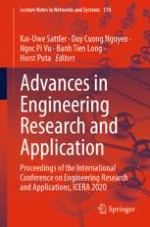2021 | Book
Advances in Engineering Research and Application
Proceedings of the International Conference on Engineering Research and Applications, ICERA 2020
Editors: Prof. Dr. Kai-Uwe Sattler, Assoc. Prof. Duy Cuong Nguyen, Assoc. Prof. Ngoc Pi Vu, Prof. Banh Tien Long, Prof. Dr. Horst Puta
Publisher: Springer International Publishing
Book Series : Lecture Notes in Networks and Systems
